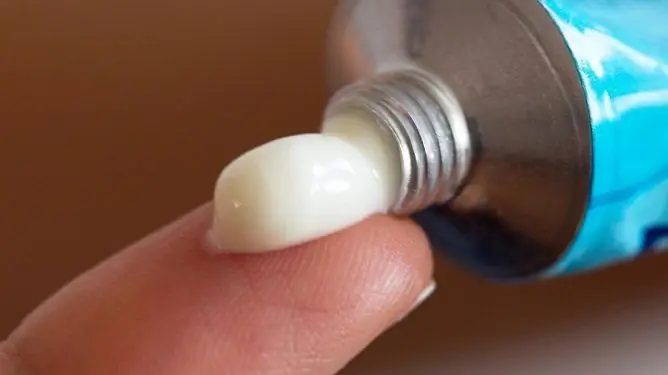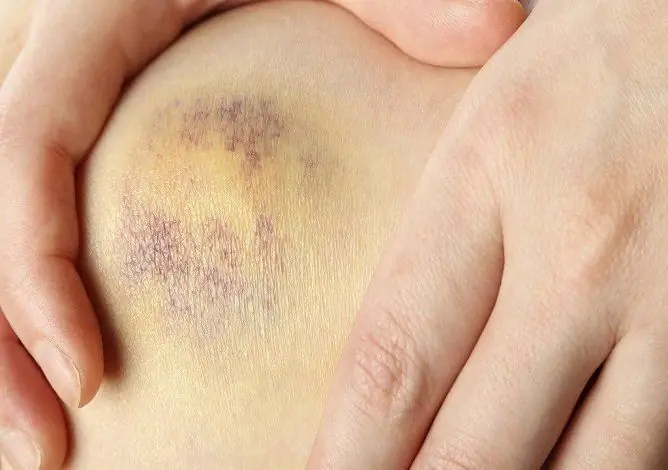- Author Rachel Wainwright [email protected].
- Public 2023-12-15 07:39.
- Last modified 2025-11-02 20:14.
Chancre
The content of the article:
- Causes
- Types of hard chancre
- Symptoms of hard chancre
- Diagnostics
- Treatment of hard chancre
- Prevention
- Consequences and complications of hard chancre
Chancre (primary syphiloma, hard ulcer) is a morphological element on the skin or mucous membranes that forms at the stage of primary syphilis - a chronic infectious disease that is predominantly transmitted sexually, the causative agent of which is Treponema pallidum (Treponema pallidum). Localization of hard chancre depends on the place of introduction of the pathogen into the body. Education can be both single and multiple.

Chancre (chancre) forms at the stage of primary syphilis
Chancre is a hard, painless ulceration that appears 10 days to 3 months after infection. When taking antibacterial drugs, the incubation period of syphilis can be lengthened. With simultaneous infection from multiple sources, the incubation period is reduced.
Causes
Infection occurs through household contact (most often sexually). In addition, the transmission of an infectious agent can be carried out during surgery, childbirth, blood transfusion, breastfeeding. Infection with treponema pale can occur through dental or other medical instruments, bed linen, personal hygiene products of a sick person, dishes. Possible way of transmission of syphilis from mother to fetus through the placenta (transplacental transmission).
Types of hard chancre
Chancre is classified according to several criteria.
Depending on the size of the ulceration:
- dwarf hard chancre (up to 10 mm);
- medium-sized hard chancre (10-25 mm);
- giant (up to 55 mm).
The most contagious is the dwarf hard chancre. Giant hard chancres are localized mainly on the abdomen, thighs, pubis, forearms, etc. (in places where the subcutaneous tissue is abundant).
By the number of ulcerations, there are:
- single;
- multiple chancres.
Multiple chancres are rare, occurring with repeated infections during the first few weeks and / or with the simultaneous introduction of an infectious agent in several places.

Multiple hard chancres
Depending on localization:
- genital chancre (on the genitals);
- extragenital (in the mouth, on the face, mammary glands, legs, near the anus, on the scalp, etc.);
- bipolar (located simultaneously on the genitals and other parts of the body).
Given the fact that infection in most cases occurs during sexual intercourse, the localization of the hard chancre is predominantly genital.
By the form of education, there are:
- typical;
- atypical (atypical) hard chancre.
Shankras of atypical form, in turn, are subdivided into:
- chancre amygdalitis (anginal) - localized in the tonsils, more often the lesion is unilateral. The mucous membrane above the amygdala changes color, the amygdala increases in size, when palpated it is compacted and painless. There may be changes in voice (hoarseness, hoarseness);
- chancre of panaritium - formed on the fingers (most often on the terminal phalanges of the index and thumb), characterized by severe shooting pains. Edema occurs at the site of the lesion. Ulceration has rough edges with suppuration within the morphological element, from which an unpleasant odor emanates. Pathology is typical for surgeons and gynecologists who perform invasive interventions, as well as for other medical workers in case of injury by contaminated medical instruments;
- inductive edema - localized mainly on the genitals. Requires differential diagnosis with pathological conditions with similar clinical manifestations. It differs from edema of other origin in that when pressed, no dents remain on it.
Atypical chancre is characteristic of cases of syphilis combination with other infectious diseases.
In addition, among the hard chancre are distinguished:
- slit-like - localized in the interdigital spaces, corners of the mouth and folds of the skin;
- diphtheria - ulceration is covered with a necrotic gray crust;
- herpetiformis - clinical manifestations are similar to genital herpes;
- Folman balanitis - characterized by multiple small erosions and a clearly defined margin.
Symptoms of hard chancre
A hard chancre occurs at the site of the pathogen introduction at the end of the incubation period of syphilis, which is often accompanied by an increase in body temperature, muscle and joint pain, an increase in regional lymph nodes and other symptoms.
Ulceration in primary syphilis usually has the form of a round or oval erosion with clear boundaries and a saucer-like shape. The exudate gives the morphological element a varnished appearance. At the base of the ulceration there is a solid infiltrate, with deep lesions, a cartilage-like structure is inherent in the infiltrate.
The hard chancre is painless, heals even in the absence of treatment in 1.5-2 months, and the ulcerative chancre is scarred, and the erosive one heals without leaving any traces. The spontaneous disappearance of the hard chancre does not mean a cure for the infection, but indicates the transition of syphilis to the secondary stage, which is more severe and dangerous. The period of healing of a hard chancre determines the nature of the infiltrate and its severity at the base. Giant hard chancres with a powerful infiltrate at the base can persist even at the stage of secondary syphilis.
In women, a hard chancre of genital localization can form on the labia majora and small labia, the clitoris, on the eve of the vagina, in the vagina, etc. In addition, a hard chancre in women is often located on the internal organs of the genitourinary tract (for example, on the cervix). In this case, the symptoms of hard chancre may go unnoticed, and this can cause further infection of sexual partners and other contacts. Inflammation is not common in typical chancre. With indurative edema, the labia majora and minora enlarge, sometimes acquiring a cyanotic hue.
Chancre in men is often localized on the body and head of the penis, the surface of the foreskin, and the urethra. When located on the urethra, the chancre is painful to palpation, interferes with urination, and bleeds. In some cases, cicatricial narrowing of the urethra is observed. In case of violation of the outflow of lymph (with damage to the lymphatic vessels), inductive edema is formed on the penis or scrotum.

With an extragenital location of a hard chancre, it can be localized in the mouth, on the lips, in the corners of the mouth
With an extragenital location of a hard chancre, it is most often localized in the mouth. The edges of the chancre are dense, red. On the lips, including the corners of the mouth, a hard chancre is covered with a yellowish crust. A hard chancre in the pharynx, on the tonsils, hard and soft palate, gums develops less often.
When pressed on a solid chancre from the sides, a yellowish liquid appears on its surface. This symptom is called "crying chancre" and serves for the differential diagnosis of syphilis from other pathologies.
The clinical picture of hard chancre with the addition of a secondary infection may change.
Diagnostics
Diagnosis of syphilis is based on the detection of pale treponemas in the discharge of a solid chancre, the results of a serological blood test and, if necessary, additional research data.
Differential diagnosis with chancre soft is required. Hard and soft chancre (chancroid) have a number of similar signs, but soft chancres are painful, have soft edges, and also form a purulent-hemorrhagic exudate.
Treatment of hard chancre
The goal of the therapy is to eliminate the infectious agent (treponema pale), restore the affected tissues, increase immunity, and prevent relapses and / or complications. Treatment can be carried out both on an outpatient basis and in a hospital setting. When determining syphilis in one of the sexual partners, diagnosis and preventive treatment is indicated for the second (other) sexual partner and contact persons. Sexual contact with an infected person should be avoided until he is fully recovered.

Antibiotics are the main treatment options for chancre.
Treatment regimens for hard chancre (i.e., primary syphilis) vary depending on the severity of the course, the location of the ulceration and a number of other reasons. The main drugs of drug therapy are antibacterial agents. They are selected individually, taking into account the probable combined infection, the sensitivity of microorganisms and the tolerance of drugs. The therapy is carried out under the control of analyzes. Sulfonamides have proven themselves well in the treatment of syphilis. Antibacterial drugs are supplemented with fortifying agents, as well as immunomodulators. In the presence of an allergic reaction, antihistamines are indicated.
In addition to general treatment, the solid chancre is treated with drugs for external use, which have anti-inflammatory, disinfecting effects. When a hard chancre is located in the mouth, rinsing the oral cavity with solutions of local antibacterial drugs is prescribed. Hygiene in the chancre area is also important.
Syphilis therapy at the initial stage of the disease (stage of hard chancre) ends with a complete cure. A neglected disease requires long-term therapy (up to several years), as well as dispensary observation of the dynamics of convalescence.
Prevention
Syphilis prevention measures include:
- protected sex;
- refusal of casual sexual relations;
- avoiding the use of other people's personal hygiene products, dishes, etc.;
- regular examination of persons belonging to risk groups (persons leading an asocial lifestyle, suffering from alcohol, drug addiction, medical workers, etc.);
- drug prevention in case of accidental unprotected sexual intercourse.
Consequences and complications of hard chancre
With the progression of the disease and the absence of the necessary treatment, the infectious process spreads to other organs and tissues of the body.
With the addition of a secondary infection, men develop inflammation of the glans penis (balanitis) and the inner surface of the foreskin (postitis), which in some cases causes such a complication of a hard chancre as narrowing of the foreskin, or phimosis. The latter is often complicated by infringement of the head of the penis by the foreskin (paraphimosis).
Attachment of a bacterial or Trichomonas infection to a hard chancre in men leads to acute inflammation around ulcerations and narrowing of the foreskin.
In addition, against the background of a weakened immune system and alcohol dependence, complications of hard chancre such as gangrene and phagedenism may occur.
In pregnant women, syphilis can cause transplacental infection of the fetus, followed by its death during the prenatal period. A child with congenital syphilis dies soon after birth or has severe internal organ damage.
YouTube video related to the article:

Anna Aksenova Medical journalist About the author
Education: 2004-2007 "First Kiev Medical College" specialty "Laboratory Diagnostics".
The information is generalized and provided for informational purposes only. At the first sign of illness, see your doctor. Self-medication is hazardous to health!






